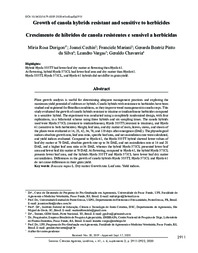Crescimento de híbridos de canola resistentes e sensível a herbicidas.
Crescimento de híbridos de canola resistentes e sensível a herbicidas.
Author(s): DURIGON, M. R.; CECHIN, J.; MARIANI, F.; DA SILVA, G. B. P.; VARGAS, L.; CHAVARRIA, G.
Summary: Plant growth analysis is useful for determining adequate management practices and exploring the maximum yield potential of cultivars or hybrids. Canola hybrids with resistance to herbicides have been studied and registered for Brazilian conditions, as they improve weed management in canola crops. This study evaluated the growth of canola hybrids resistant to triazine or imidazolinone herbicides compared to a sensitive hybrid. The experiment was conducted using a completely randomized design, with four replications, in a bifactorial scheme using three hybrids and six sampling times. The canola hybrids used were Hyola 571CL (resistant to imidazolinones), Hyola 555TT (resistant to triazines), and Hyola 61 (sensitive to both herbicides). Height, leaf area, and dry matter of roots, leaves, stems, and shoots of the plants were evaluated at 14, 28, 42, 56, 70, and 119 days after emergence (DAE). The physiological indices absolute growth rate, leaf area ratio, specific leaf area, and net assimilation rate were calculated, and yield indices evaluated. Compared to Hyola 61, the Hyola 555TT hybrid showed lower values of leaf dry matter at 70 DAE, absolute growth rate up to 56 DAE, and net assimilation rate at 14 and 28 DAE, and a higher leaf area ratio at 56 DAE, whereas the hybrid Hyola 571CL presented lower leaf area and lower leaf dry matter at 70 DAE. At flowering, compared to Hyola 61, the hybrid Hyola 571CL presents lower leaf area, and the hybrids Hyola 555TT and Hyola 571CL have lower leaf dry matter accumulation. Differences in the growth of canola hybrids Hyola 555TT, Hyola 571CL and Hyola 61 do not cause differences in their grain yield. Key words: Brassica napus L. Dry matter. Growth rate. Leaf area. Yield indic
Publication year: 2020
Types of publication: Journal article
Unit: Embrapa Wheat
Keywords: Brassica napus L, Dry matter, Growth rate, Leaf area, Yield indices
Observation
Some of Embrapa's publications are published as ePub files. To read them, use or download one of the following free software options to your computer or mobile device. Android: Google Play Books; IOS: iBooks; Windows and Linux: Calibre.
Access other publications
Access the Agricultural Research Database (BDPA) to consult Embrapa's full library collection and records.
Visit Embrapa Bookstore to purchase books and other publications sold by Embrapa.

